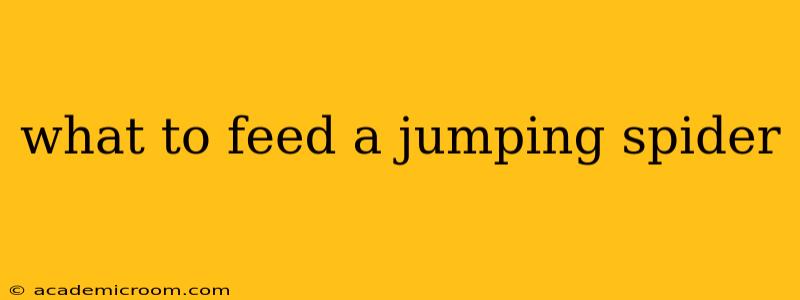Jumping spiders, with their captivating eyes and acrobatic hunting style, make fascinating pets. Providing them with the right diet is crucial for their health and longevity. This guide will delve into the best foods for your jumping spider, addressing common questions pet owners have.
What insects do jumping spiders eat?
Jumping spiders are carnivores, primarily feeding on insects. Their diet in the wild is incredibly diverse, but in captivity, it's best to stick to smaller, readily available insects. Excellent choices include:
- Fruit flies (Drosophila): These are a staple food for many smaller jumping spider species. They're readily available, easy to culture, and are the perfect size for many spiderlings and smaller adults.
- Mealworms (Tenebrio molitor larvae): While larger, mealworms offer a good source of protein. Make sure to offer smaller mealworms to your smaller spiders and offer them only occasionally, as their chitinous exoskeletons can be difficult to digest in large quantities.
- Houseflies: Another good option, though slightly more challenging to keep as a live food source.
- Pinhead crickets: These tiny crickets are ideal for spiderlings and smaller jumping spiders.
- Springtails (Collembola): These small, wingless arthropods are a good supplementary food source, particularly for smaller spiders.
How often should I feed my jumping spider?
Feeding frequency depends on the age and size of your spider. Generally:
- Spiderlings: Should be fed daily or every other day, offering several small insects at each feeding.
- Adult spiders: Can be fed every 2-3 days, offering 1-3 insects depending on their size.
Always monitor your spider's feeding habits and adjust accordingly. If they're not eating, there may be an underlying health issue. Remove any uneaten insects after a few hours to prevent the enclosure from becoming unsanitary.
Can I feed my jumping spider other things besides insects?
No. Jumping spiders are obligate carnivores, meaning their bodies are specifically adapted to digest insects and other small arthropods. Do not attempt to feed your jumping spider anything else, such as fruits, vegetables, or other non-insect foods. This will not provide the necessary nutrition and could potentially harm them.
What size insects should I feed my jumping spider?
The size of the prey should be roughly no larger than the spider's abdomen. Offering prey that's too large can be stressful and even dangerous for your spider. Smaller prey is always preferable, especially for smaller spiders.
My jumping spider isn't eating. What should I do?
Several factors can cause a jumping spider to refuse food. These include:
- Molting: Jumping spiders stop eating before and during molting.
- Stress: A new environment, improper temperature or humidity, or disturbance can cause stress and reduce appetite.
- Illness: If your spider is consistently refusing food, it may be ill and require veterinary attention (a specialist in arachnids).
Where can I get food for my jumping spider?
You can obtain insects for your jumping spider from various sources:
- Pet stores: Many pet stores sell live insects suitable for jumping spiders.
- Online retailers: Several online retailers specialize in supplying live insects for reptile and invertebrate keepers.
- Culturing your own: Culturing fruit flies is a popular method among jumping spider keepers, as it provides a consistent and convenient food source.
Remember, responsible pet ownership includes providing the appropriate diet and care for your jumping spider. By following this guide, you can ensure your arachnid companion thrives.
